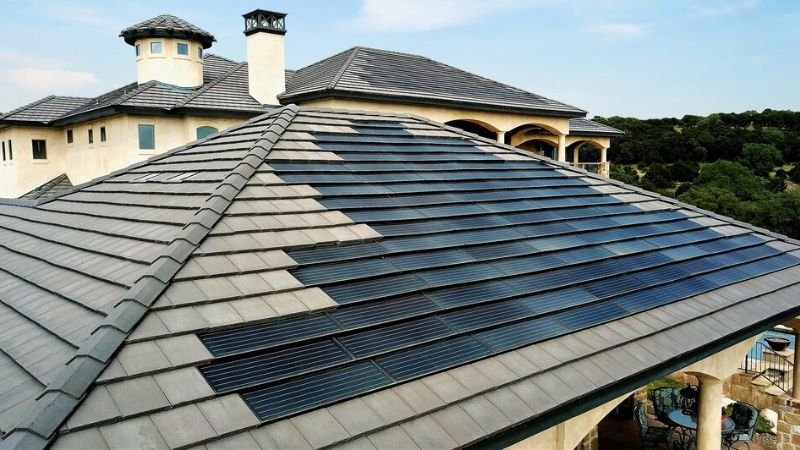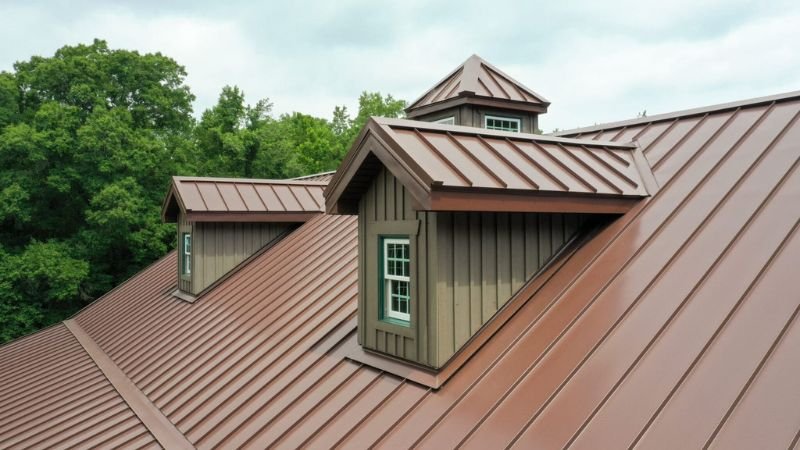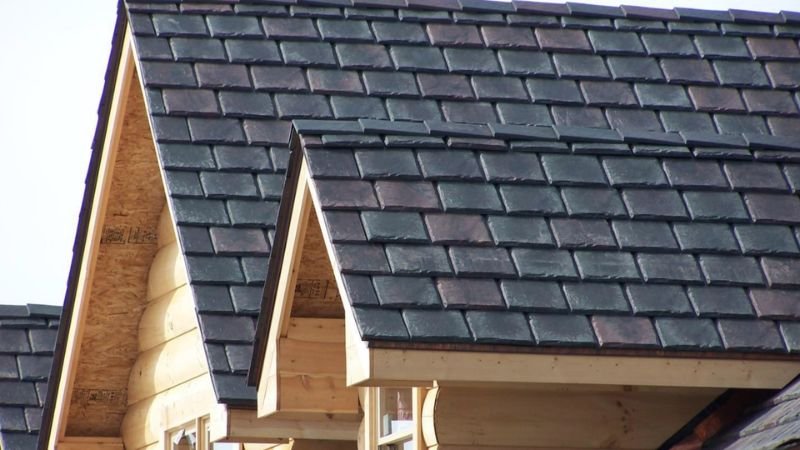We provide both traditional asphalt shingles and contemporary metal roofing.Choosing the right roofing material is a critical decision that impacts your home’s durability, energy efficiency, and aesthetic appeal. With a myriad of options available, it can be overwhelming to select the best one for your needs. In this guide, we will explore 10 different types of roofing materials, each with its unique advantages and drawbacks. Whether you are building a new home or planning to replace an existing roof, understanding the characteristics of these materials will help you make an informed choice. From classic asphalt shingles to modern metal roofing, we’ve got you covered.
10 Different Types Of Roofing Materials For Your Home
Asphalt Shingles
With good reason, asphalt shingles are the most widely used roofing material in North America. They are affordable, easy to install, and come in a variety of colors and styles to match any home’s exterior. These shingles are made from a fiberglass base mat coated with asphalt and mineral granules, which provide excellent protection against UV rays and weather elements. The affordability of asphalt shingles is one of their main benefits. They are among the least expensive roofing materials, making them a great option for budget-conscious homeowners. Additionally, asphalt shingles are relatively easy to repair and replace, which can save you money on maintenance over the long term.
Metal Roofing
Recent years have seen a rise in the popularity of metal roofing because of its toughness, energy efficiency, and sleek design. Metal roofs are available in various materials, including aluminum, steel, copper, and zinc, each offering distinct benefits. One of the main advantages of metal roofing is its longevity; a well-installed metal roof can last 50 years or more. Additionally, metal roofs are highly resistant to weather elements, including wind, rain, and snow, making them an excellent choice for areas with extreme weather conditions.
Another benefit of metal roofing is its low energy consumption. Metal reflects solar radiant heat, which can reduce cooling costs by up to 25% in the summer. This reflective property makes metal roofs an eco-friendly option, as they help reduce the urban heat island effect. However, metal roofs can be more expensive to install than other materials, and the initial investment can be higher. Additionally, they may make noise during hailstorms or rain, however this can be lessened with the right insulation. Despite the higher upfront costs, the durability and energy savings offered by metal roofing make it a worthwhile investment for many homeowners.
Wood Shingles and Shakes
Wood shingles and shakes offer a natural, rustic aesthetic that is highly appealing to many homeowners. Made from cedar, redwood, or pine, these roofing materials can enhance the beauty of any home with their distinctive, textured appearance. Wood shingles are machine-cut for a more uniform look, while shakes are hand-split, giving them a more rugged, uneven texture. The environmental friendliness of wood roofing is one of its key benefits. Since wood is a renewable resource, many producers get their supplies from forests that are managed sustainably.
In terms of performance, wood shingles and shakes provide good insulation and allow the roof to breathe, which can help regulate indoor temperatures. They are also relatively durable, with a lifespan of around 30 years if properly maintained. However, wood roofing requires regular maintenance to prevent issues such as mold, rot, and insect damage. Additionally, wood is more susceptible to fire, although treatments are available to enhance its fire resistance. Despite these challenges, wood shingles and shakes remain a popular choice for their unique aesthetic and environmental benefits.
Slate Roofing
Slate roofing is renowned for its elegance, durability, and timeless appeal. Made from natural stone, slate tiles are incredibly durable and can last over 100 years with proper maintenance. This longevity makes slate one of the most long-lasting roofing materials available. In addition to its durability, slate is highly resistant to fire, mold, and mildew, which helps maintain its appearance and functionality over time. Slate roofs are also highly energy-efficient, providing excellent insulation and helping to regulate indoor temperatures.
Clay and Concrete Tiles
Clay and concrete tiles are popular in areas with warm climates, such as the Mediterranean and southwestern United States. These tiles are known for their durability, energy efficiency, and aesthetic appeal. Clay tiles are made from natural clay that is shaped and baked, while concrete tiles are made from a mixture of sand, cement, and water. Both types of tiles are available in a variety of colors and styles, allowing homeowners to achieve a traditional or contemporary look.
One of the main advantages of clay and concrete tiles is their longevity. These materials can last 50 years or more, with clay tiles often outlasting concrete ones. They are also highly resistant to fire, rot, and insect damage, making them a low-maintenance option. Additionally, the thermal mass of clay and concrete tiles helps regulate indoor temperatures, reducing cooling costs in hot climates. However, clay and concrete tiles are heavy, and not all structures can support their weight without reinforcement. They can also be more expensive to install compared to other materials. Despite these considerations, many homeowners choose clay and concrete tiles for their durability, energy efficiency, and distinctive appearance.
Synthetic Roofing
Synthetic roofing materials, such as rubber, plastic, and polymer-based products, are designed to mimic the appearance of natural materials like slate, wood, and tile. These materials offer a cost-effective and lightweight alternative to traditional roofing options while providing excellent durability and performance. Synthetic roofing is often made from recycled materials, making it an environmentally friendly choice for homeowners.
One of the main benefits of synthetic roofing is its versatility. These materials can be manufactured in a variety of styles and colors to match any home’s aesthetic. Synthetic roofing is also highly resistant to weather elements, including wind, rain, and UV rays, and can last 30-50 years with proper maintenance. Additionally, synthetic materials are lightweight, which reduces the structural load on the home and simplifies the installation process. However, synthetic roofing can be more expensive than some traditional materials, and not all products are created equal in terms of quality and performance. It is important to choose a reputable manufacturer to ensure the longevity and durability of your synthetic roof.
Green Roofing
Green roofing, also known as living roofs, involves growing vegetation on the roof’s surface. This type of roofing provides numerous environmental benefits, including improved air quality, reduced urban heat island effect, and enhanced stormwater management. Green roofs can be either extensive, with a thin layer of soil and low-maintenance plants, or intensive, with a deeper soil layer and a variety of vegetation, including trees and shrubs.
One of the main advantages of green roofing is its ability to improve energy efficiency. The vegetation acts as an insulating layer, reducing heating and cooling costs by regulating indoor temperatures. Green roofs also help to extend the lifespan of the underlying roofing material by protecting it from UV rays and weather elements. However, green roofing requires a significant initial investment and ongoing maintenance to ensure the health of the vegetation. Additionally, not all structures are suitable for green roofing, as it requires a strong support system to handle the additional weight. Despite these challenges, green roofing is gaining popularity for its environmental benefits and aesthetic appeal.
Solar Roofing
Solar roofing integrates photovoltaic panels into the roof’s structure, allowing homeowners to generate electricity from sunlight. This type of roofing is an excellent choice for those looking to reduce their reliance on traditional energy sources and lower their carbon footprint. Solar roofing is available in various forms, including solar panels, solar shingles, and solar tiles, each offering distinct advantages and aesthetic options.
One of the main benefits of solar roofing is its potential to significantly reduce or eliminate electricity bills. By generating their own electricity, homeowners can save money on energy costs and even sell excess power back to the grid in some areas. Solar roofing also increases the overall energy efficiency of the home and can enhance its resale value. However, the initial cost of solar roofing can be high, although incentives and rebates are often available to offset the expense. Additionally, the efficiency of solar roofing depends on the geographic location and the amount of sunlight the roof receives. Despite these considerations, many homeowners choose solar roofing for its long-term cost savings and environmental benefits.
Metal Shingles
Metal shingles combine the durability and energy efficiency of metal roofing with the traditional appearance of shingles. These shingles are made from various metals, including aluminum, steel, and copper, and are designed to mimic the look of asphalt, wood, or slate shingles. Metal shingles offer a versatile and stylish roofing option that provides excellent performance and longevity.
The longevity of metal shingles is one of their key benefits. They are highly resistant to weather elements, including wind, rain, and hail, and can last 50 years or more with proper maintenance. Metal shingles are also energy-efficient, reflecting solar radiant heat and reducing cooling costs in the summer. Additionally, metal shingles are lightweight, which reduces the structural load on the home and simplifies the installation process. However, metal shingles can be more expensive than some traditional materials, and the initial investment can be higher. Despite these considerations, many homeowners choose metal shingles for their durability, energy efficiency, and stylish appearance.
Rubber Roofing
Rubber roofing, also known as EPDM (ethylene propylene diene terpolymer) roofing, is a synthetic material commonly used for flat or low-slope roofs. This type of roofing is known for its durability, flexibility, and resistance to weather elements. Rubber roofing is made from recycled materials, making it an environmentally friendly choice for homeowners.
One of the main benefits of rubber roofing is its longevity. It can last 30-50 years with proper maintenance, and it is highly resistant to UV rays, ozone, and weather elements. Rubber roofing is also flexible, which allows it to expand and contract with temperature changes without cracking or splitting. Additionally, rubber roofing is easy to install and repair, and it requires minimal maintenance over its lifespan. However, rubber roofing can be more expensive than some traditional materials, and it may not be suitable for all roof types. Despite these considerations, many homeowners choose rubber roofing for its durability, flexibility, and environmental benefits.
Conclusion
Selecting the perfect roofing material is essential for safeguarding your home and enhancing its overall appearance. By understanding the features and benefits of these 10 different types of roofing materials, you can make a well-informed decision that suits your needs and budget. Remember, a good roof not only protects but also adds value to your home. Choose wisely!
FAQs
What is the most cost-effective roofing material?
Asphalt shingles are often considered the most cost-effective option due to their affordability and ease of installation.
Which roofing material is the most durable?
Metal roofing is known for its exceptional durability, often lasting 50 years or more with proper maintenance.



